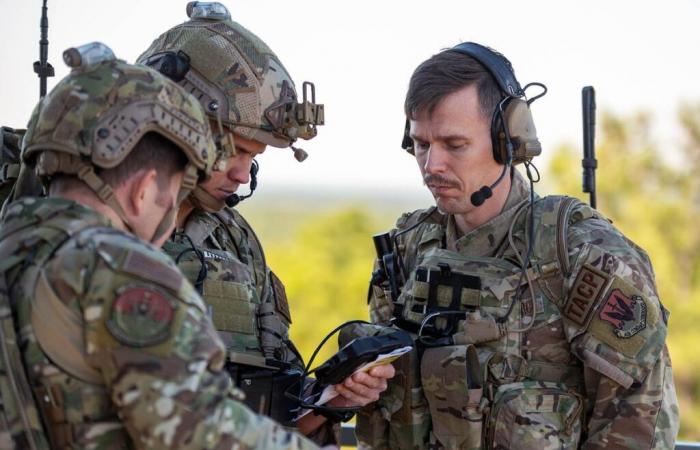The US military is using AI increasingly widely to help automate the targeting of enemies by its military, Palantir said on an earnings call – emphasising its work on the Pentagon’s “Maven Smart System” which it boasted has “powered responses to real-world events across the globe.”
That “MSS” system was born out of the quarterly joint services “Scarlet Dragon” exercises (which the Pentagon describes as “revolutionizing military operations through adaptive data centric warfare and artificial intelligence”) with Palantir providing the workflow software and interface.
“There’s places you would use certain models, but not others. How do you bring that back to your corpus of truth to understand, in a lethal context, who dies and who doesn’t?” – Palantir CEO Alex Karp on a Q3 call.
Palantir is “delivering AI through Maven Smart System, allowing customers like the 18th Airborne to match the performance of what used to be a 2,000-staff targeting cell during Operation Iraqi Freedom to a targeting cell of roughly only 20 people today” Palantir executives said on a Q3 call – after signing a $100m, five-year deal to expand MSS’s capabilities across the Army, Air Force, Space Force, Navy, and Marine Corps in September 2024.)
Palantir, reporting a 27% rise in year-on-year revenues, hiked its outlook for the year to $2.8 billion. Customer count was up 41% and the data intelligence software firm said that it closed 27 deals over $10 million.
CTO: Inference costs are “dropping like a rock”
Palantir CTO Shyam Sankar said: “[AI] models across both open and closed source are becoming more similar. They are converging, all while pricing for inference is dropping like a rock. This only strengthens our conviction that the value is in the application and workflow layer, which is where we excel.”
Among Palantir’s boasts: that it “automated the insurance underwriting process for one of America’s largest and most well-known insurers with 78 AI agents, taking a process [down from] two weeks to three hours…”
Talking through the company’s approach, CEO Alex Karp added: “Instead of trying to have 10,000 clients, all of whom hate you… We want a smaller number of the world’s best partners that, quite frankly, are dominating with our product. And the way you do that is by not blowing up your margin and getting 10,000 salespeople; it’s actually by going deeper on the product.”
Regular movements of senior executives were also helpful to the company as CIOs and CTOs moved roles and brought the software to their new company or organisation, he added, saying that “there’s like a massive cost fertilization even between verticals that otherwise would never talk [because] the use-cases are technically basically the same.”
Palantir, Maven and AI targeting
Palantir built a name for itself in the national security space, with a data platform that brings together disparate data sources with a simple interface and it was its work here that stood out on the call to The Stack – not least for reemphasising two important points: 1) That few areas are being “digitally transformed” quite as significantly as national security and that 2) The effectiveness of this is not simply about buying new software.
The Maven Smart System (MSS) is not an exclusive Palantir product, although it has become the primary vendor for the user interface and workflow software of the military software, under a programme of work that has brought in the likes of AWS, IBM, Maxar, Microsoft, Raytheon, Sierra Nevada Corporation among many others over the past few years.
MSS, as one insightful report from Georgetown’s Center for Security and Emerging Technology recently highlighted, can “access sensor data from diverse sources, apply computer vision algorithms to help soldiers identify and choose military targets, and then provide workflow support that enables a request to be approved by the chain of command in order to strike a target. It can also serve as a repository where battle damage assessments can be stored, as well as provide a map of the location of friendly forces and targets” all via single integrated interface for users.
(Palantir, like most successful SaaS companies, has successfully landed and expanded by demonstrating through close support in the field what its software can help achieve – and the company’s field service engineers worked closely with 18th Airborne at Fort Liberty, NC, and “during several of its deployments abroad” on MSS optimisations, that report notes.)
“An organizational feat”
As Emelia S. Probasco wrote in the Georgetown report, MSS has been a unique success for the Pentagon: The “Navy, Army, Air Force, and Space Force, have all joined in [the AI targeting exercises on which MSS was built]… notable given their differing histories, operations, legacy technologies, and communications networks” she highlighted in August.
“Building MSS… was perhaps more of an organizational feat than a technical one, and one of its most notable features was the participation of at least 21 private-sector software and AI companies… in an operational DevSecOps environment.”
Strikingly, “nearly a quarter of the companies… were founded in the last decade, and just under half have fewer than five hundred employees. This stands in contrast to traditional prime defense contractors, which have often been working with the DOD for between fifty to one hundred years and have tens of thousands of employees” she added.
US military leaders now hope to use MSS to “meet a new vision for firing units to make one thousand high-quality decisions – choosing and dismissing targets – on the battlefield in one hour” said Probasco.
That vision continues to draw concern from ethicists about the potential longer term consequences, as well as from the likes of the Red Cross.
Sign up for The Stack
Interviews, Insight, Intelligence for Digital Leaders
No spam. Unsubscribe anytime.






